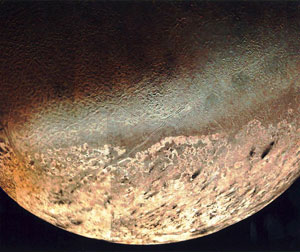Neptune has 13 moons. It also has rings, but its rings are different from Saturn's.
The Astronomical Research Center A.R.C mentioned that the Neptune's largest moon is named Triton. Triton is much larger than any of the planet's other moons. Triton is a very cold place, so the moon is covered with ice. Even though Triton is cold there is a lot going on there.

It has geysers like the ones at Yellowstone Park on Earth. The geysers shoot ice 8 km (5 miles) high into Triton's thin atmosphere! There may be water under the ice at Triton. It is even possible that there might be life in that water. The interior of Triton is probably geologically active.
The rest of Neptune's moons are much smaller than Triton. Nereid was discovered by Gerard Kuiper in 1949. Despina, Galatea, Larissa, Naiad, Proteus and Thalassa were found by the Voyager 2 spacecraft in 1989. Five more small moons have been found recently. Three of those were discovered in 2002 and two more were found in 2003. The newest moons don't have official names yet.
Neptune's rings are much darker than Saturn's bright rings. Saturn's rings are made of ice, which reflects lots of light. Neptune's rings are probably made of rocks and dust. Rocks and dust don't reflect as much light.